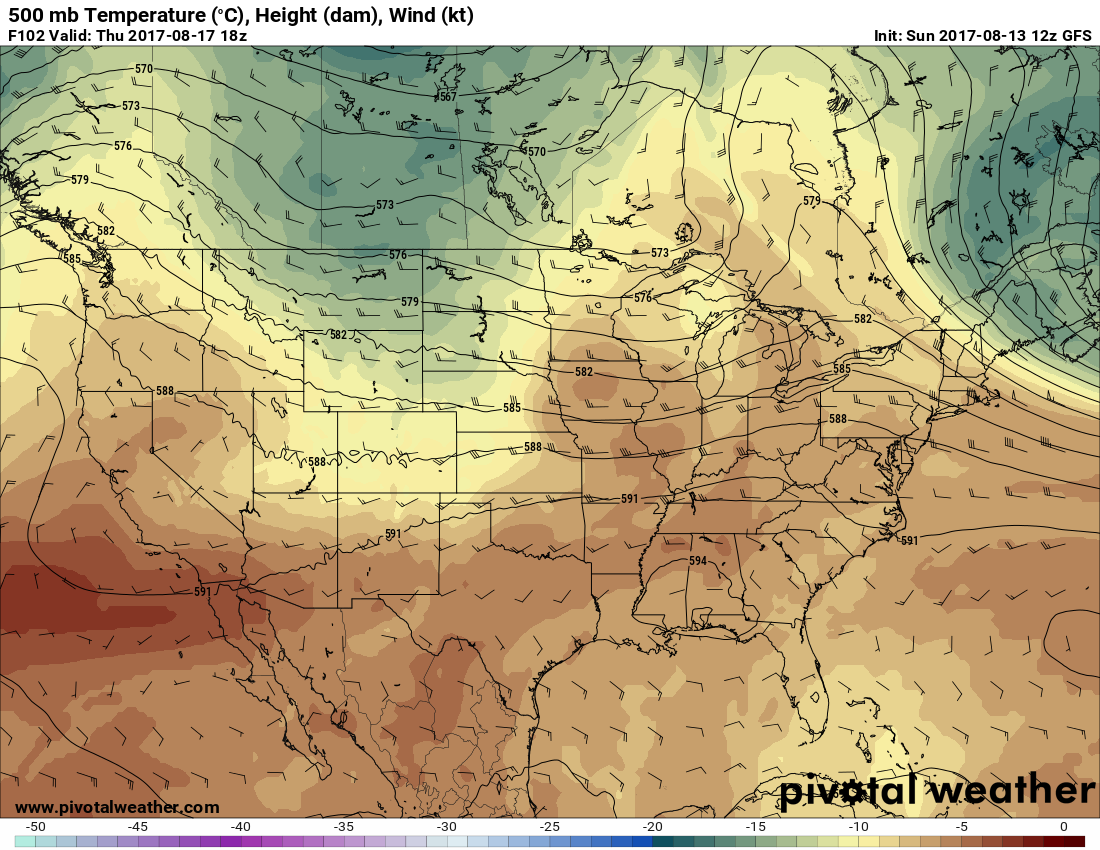Sunday August 13th…
Dear diary. The only heat advisories for today are in coastal areas of Texas:

As stated on Saturday there should be some areas of fairly typical, but dangerous, heat across portions of the South this week. I’m not willing to arbitrarily designate what will happen a “heat wave,” though.
This fairly looking zonal pattern at 500 Mb is what will be occurring for much of this week:

A few bubbles of 594+ heights will occur from time to time ratcheting up the heat, such as the one depicted in the above chart in Alabama, but this is typical for mid-August.
Tomorrows maxes will be similar to those of Sunday, except it will be cooler in the northern Rockies and warmer in the western Plains:

Dangerous heat will continue in portions of Texas due to the combination of temperatures well above 90F and high humidity.
Here are Sundays maxes:

Dangerous heat was confined to positions of the Southeast, Texas, and the deserts of the Southwest. The rest of the nation had excellent temperatures by mid-August standards.
The Climate Guy
Saturday August 12th…
Dear diary. Today in between fairly big heat events, I’m going to revisit an index that I hope will be useful in the future once the thing has gone through some sort of peer review. This would be the Extreme Temperature Index that compares record temperatures, which Bob Henson and I concocted in 2007. In the process I’ll be giving out the hot and cold awards for July 2017.☺
A thorough description in a Weather Underground Category 6 blog of the ETI can be found here:
Let’s reintroduce the ETI formula.
First, the current algorithm and formula for the Extreme Temperature Index are presented here:
![]()
 What we will do is compare the “most extreme” hot and cold records of July 2017 that I can see in the NCEI database.
What we will do is compare the “most extreme” hot and cold records of July 2017 that I can see in the NCEI database.
Let’s start with the hot record (and award): Sitka AK, which got up to 86 and broke their record by 15F. Yep, the award goes to a location in the nation’s coldest state, which broke its record by the greatest amount of any other records in the NCEI database during July 2017. Due to carbon pollution Alaska is the fastest warming U.S. state.

Now let’s select the cold record. That is Ballinger TX. Again, we are looking for the most “extreme” cold event, climatologically, that occurred in July 2017, and this happened to be in one of the typically hotter states in the U.S. For the ETI calculation I used the average max/min at San Angelo TX, which is the closest large station to Ballinger.

Last month the hot record trumped the cold record mainly because Sitka AK is close to the Pacific and has more of a marine climate than Ballinger, TX. (The higher T sub D is… see the ETI algorithm … the more “continental” the site. In other words, the difference between the typical maximum and minimum temperature is usually higher the further away a station is from a large body of water… and thus more continental. It’s harder for a station with a low climatological difference between their average maximum and minimum than one with a higher difference.
O.K. So is there any dangerous heat across the U.S. today? Why yes looking at the orange and purple colors on the NWS advisory map in Texas and the Pacific Northwest:
 Extreme heat in the Pacific Northwest should end by tomorrow due to a Pacific front. Hot pockets, such as the one in Texas, will be appearing on this map sporadically this coming week. There might be a low grade heat wave in the southern U.S.
Extreme heat in the Pacific Northwest should end by tomorrow due to a Pacific front. Hot pockets, such as the one in Texas, will be appearing on this map sporadically this coming week. There might be a low grade heat wave in the southern U.S.
In Texas here is a closer look at today’s dangerous heat:

 Here are the expected maxes for Sunday:
Here are the expected maxes for Sunday:

This is a fairly typical looking map for mid August.
Here is a hot tidbit for this evening from MDA Weather Services in association with the Pacific Northwest heat wave. Yakima WA had more 100F days (9) than at any time since records have been kept there starting in 1947 for this August:

Here are today’s maxes:

The Pacific Northwest continued to cool. The only really hot states of any consequence were California and Texas.
To see all 2017 Heat Diary entries click:
https://guyonclimate.com/category/heatdiary2017/
The Climate Guy